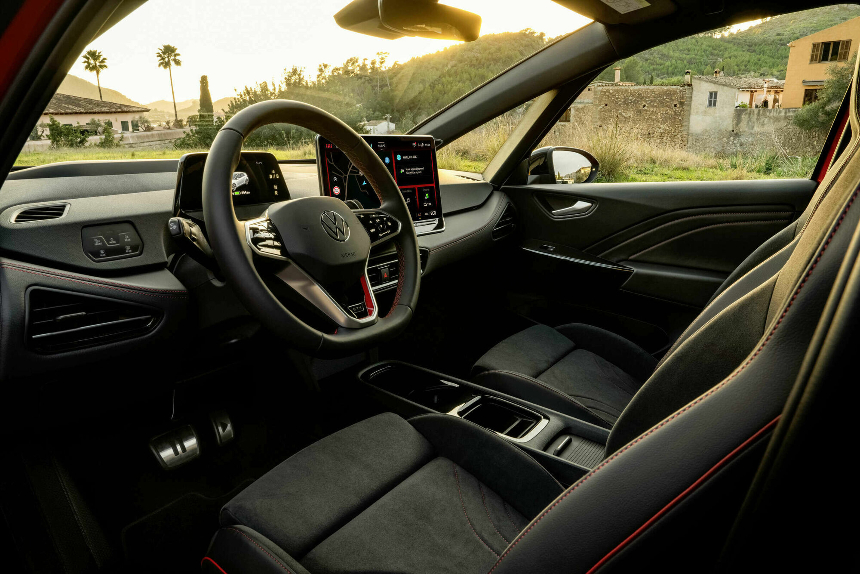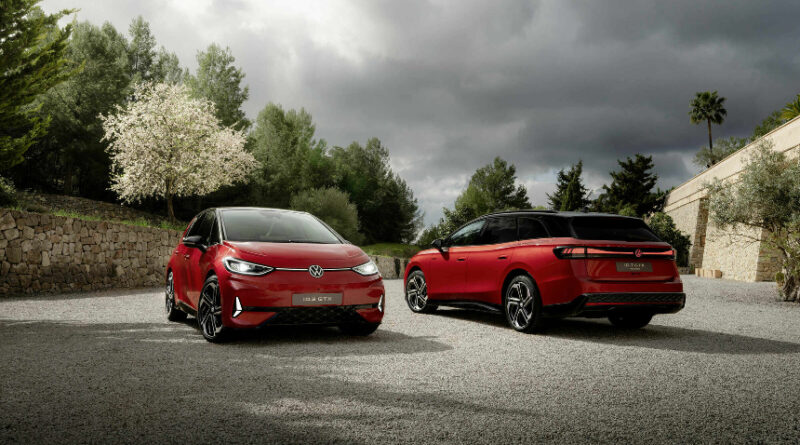Performance Electric Car Models Coming From Volkswagen & Hyundai
The news today is filled with announcements from Volkswagen and Hyundai about new high performance electric car offerings. Those of us who already drive an electric car know the instant torque they have available — electric motors generate their maximum torque at zero rpm — is one of the things that sets those cars apart from their cousins with infernal combustion engines.
ID.3 GTX & ID.7 Tourer GTX Electric Car Models
But can there be too much of a good thing? The answer, apparently, is no. Volkswagen says 20% of its ID.4 and ID.5 sales in Europe are GTX versions of those models. GTX is the designation the company uses to identify the most potent performers in its lineup.
It is a reference to the now famous GTI versions of its combustion engine vehicles that started with the Golf GTI (Rabbit GTI in North America) in September, 1975. To distinguish performance versions of its electric cars from its GTI-badged gasoline powered cousins, the company has created the GTX category for its battery-electric models. GTIs have always featured red accents on the exterior and interior and the GTX versions will carry on that tradition. None of the new GTX models are intended for customers in North America, but European buyers can expect them to go on sale shortly.
Volkswagen ID.3 GTX

The Volkswagen ID.3 GTX features one electric motor powering the rear wheels. (Two years ago, the company said it would have dual motors.) It is available with either a 210 kW (282 hp) motor or a 243 kW (322 hp) motor in the “Performance” version. (We thought the GTX was the performance version.) The more powerful motor is said to push the car to 100 km/h in just 5.6 seconds — almost half of what the GTI required in 1975.
According to Volkswagen, the ID.3 GTX comes with bespoke 20″ wheels and a raft of exterior and interior touches that highlight its special nature. It also has a slightly larger battery (82 kWh) and the performance version has special DCC adaptive dampers to tame the most exuberant driving styles.

Kai Grünitz, the Volkswagen Brand board member responsible for development, says: “With its spontaneous and superior power delivery, the new ID.3 GTX Performance is for me the electric counterpart to our sporty compact icon, the Golf GTI Clubsport. Of course, an electric drive and a turbocharged petrol engine each have their own unique character. Yet the ID.3 GTX Performance and the Golf GTI Clubsport share the same fascinating lightness when they accelerate. With the ID.3 GTX, Volkswagen is transferring the almost 50 year tradition of its compact GT models into the world of electric mobility. Driving pleasure is guaranteed.”
Volkswagen ID.7 Tourer GTX

The other car getting the GTX treatment is the recently introduced ID.7 Tourer. It features a dual motor all-wheel drive powertrain that packs 250 kW (335 hp), making it the most powerful wagon VW has ever produced.
Design changes include a GTX-specific front bumper and honeycomb grille along with black painted accents everywhere and unique light graphics. It also gets 20-inch wheels, plus GTX-specific seats and steering wheel. Red accents similar to those found in the ID.3 GTX can be seen throughout the cabin of the ID.7 version as well.
Kai Grünitz says, “The ID.7 GTX Tourer paves the way for a new type of sporty mobility by combining the spaciousness of a large estate with the performance of a sports car. What is fascinating here is the instantaneous punch with which the electric motors provide their maximum output and torque in fractions of a second.”
 Chip in a few dollars a month to help support independent cleantech coverage that helps to accelerate the cleantech revolution!
Chip in a few dollars a month to help support independent cleantech coverage that helps to accelerate the cleantech revolution!
Hyundai Ioniq 5 N

Sharpeyed readers will notice that Volkswagen did not mention anything about prices or range for either of the new GTX models. Hyundai is making no bones about the cost of its new Ioniq 5 N, a car The Street calls a “Porsche fighting track weapon.” That may be a bit of hyperbole. No one is going to mistake an Ioniq 5 for Taycan, but the performance of this particular electric car is fairly stout nonetheless. All Hyundai racing programs are conducted by the company’s N division.
Hyundai says the Ioniq 5 N is “the new benchmark for high performance, all electric driver engagement” and will be priced at $66,100 before a $1,375 destination charge. Call it $67,475 out the door. Since the car is built in South Korea, it is not eligible for the federal electric car tax credit/rebate. In comparison, the Tesla Model Y Performance is $52,490 plus a $1390 destination charge and it is eligible for the tax credit/rebate.
However, Autoblog points out the Ioniq 5 N includes a driver assistance platform that is similar to the Tesla Full Self Driving package, which costs an additional $12,000. Nevertheless, the Tesla pencils out at $58,380 after the rebate, which is still about $9,000 less than the Hyundai. Some drivers may question the claim that the Hyundai automated driving system is a match for Tesla’s FSD, but that’s why they make Coke and Pepsi. Yer pays your money and yer takes your choice.
As opposed to the bare bones information about the new GTX models from Volkswagen, the Ioniq 5 N press release is packed with extensive details. So what’s under the skin of this pocket rocket? Here are the specs Volkswagen omitted.
- Motor output — Front 166 kW/223 HP, Rear 282 kW/378 HP
- Total output — 448 kW/601 HP
- N Grin Boost output — 478 kW/641 HP
- Battery Capacity — 84 kWh
- Charge Speed — 238kW (when connected to a DCFC 350 kW charger)
- Charge time — 10% to 80% in 18 minutes
- Tires — Pirelli P Zero 275/35R21
- Braking system — Front, 4 piston (15.75 in) Rear, 1 piston (14.2 in.)
- Regenerative braking deceleration — 0.6 g (0.2 g during ABS activation)
- 0 – 60 mph — Approximately 3.25 sec. (w/ N Launch Control and Grin Boost function utilized)
- Top speed — 162 mph (electronically limited)

A Stiffer Electric Car For Sharper On-Track Performance
The body of the Ionic 5 N has 42 additional weld points and 6.9 feet of additional structural adhesive. The motor and battery mounts have been reinforced, while front and rear sub-frames have been stiffened for increased lateral rigidity. World Rally Championship-derived integrated drive axles have been fitted front and rear to handle the increased torque of the electric motors.
To enhance response and feedback, the steering has been strengthened for improved rigidity and includes a specially tuned rack mounted motor driven power steering system that incorporates a quicker ratio and enhanced steering feedback.
“N Pedal” has been developed to address the inherent weight and size of electric powertrains to deliver the responsive handling characteristics found in Hyundai’s championship-winning i20 N WRC cars. This intelligent software function is designed to provide instant turn-in and enhanced throttle sensitivity. Drawing on similar technology used in i-Pedal’s regenerative braking system, N Pedal prioritizes fast, exhilarating cornering over absolute energy efficiency. By utilizing greater decelerating force, weight can be transferred aggressively onto the front axle, resulting in sharper, more confident turn-in.
N Drift Optimizer helps to maintain the driver’s desired drift angle by balancing multiple vehicle controls and responding to real time inputs. A novel Torque Kick Drift function allows the driver to simulate the clutch-kick action of a rear-wheel drive internal combustion vehicle to initiate and sustain easier drifts in this driver-selectable mode.
N Torque Distribution provides fully variable front and rear torque distribution that can be adjusted to the driver’s choice of 11 levels. The rear axle electronic limited-slip differential optimizes cornering performance and control. Additional wheel sensors and upsized dampers with wider damping ranges broaden the overall tuning envelope of IONIQ 5 N’s electronically controlled suspension, enabling driving characteristics from everyday sports car through full racetrack capability.
Several exclusive features aid in track performance. N Grin Boost (thank you, Hyundai PR department) maximizes acceleration with extra power over 10 second intervals. N Launch Control automatically activates N Grin Boost during launch and provides three different traction levels for the best possible acceleration, allowing drivers to launch their vehicle like a race car. Track SOC (state of charge) automatically calculates battery consumption every lap, maximizing driver confidence.
Special battery cooling helps manage heat while on track. N battery pre-conditioning can be utilized to bring battery cells to the most power efficient temperature, choosing between ‘Drag’ mode for short bursts of full power or ‘Track’ mode, which optimizes the lowest possible battery temperature for sustained lapping. This is not a car designed to negotiate the parking lot at the mall.
Performance enthusiasts have long lamented a lack of involvement and feedback behind the wheel of many EVs due to the fundamental nature of electric power delivery. Hyundai N engineers developed driver-selectable N e-shift and N Active Sound+ functions to deliver unprecedented EV feedback and precise control during dynamic driving. The unique emphasis on precise power modulation differentiates the N approach to engagement from other EVs.
N e-shift simulates the 8-speed dual clutch transmission found in N’s internal combustion engine-powered cars. This technology replicates gearshifts by controlling motor torque output and simulating the power-shift feeling between gear changes, including synchronized audible cues. There’s even a synthetic redline. As a result, IONIQ 5 N delivers a more entertaining and interactive driving experience that feels far closer to a high-performance ICE model than other EVs. (Apparently just driving a car well is not enough of a thrill for some drivers.)
The Takeaway
Volkswagen has chosen to increase the performance of its ID.3 and ID.7 Tourer models with a GTX upgrade. Hyundai has chosen to go full boy racer with its Ioniq 5 N. 20 years ago, there was a horsepower war between the Subaru WRX STi and the Mitsubishi EVO 5. Now it appears that the world of electric cars is ready for a reprise of that era with an assortment of high performance vehicles for specialized driving needs.
Hyundai is clearly gunning for top honors in the performance electric car category, but lapping the Nordschleifer is not on most people’s agenda. If the Ioniq N floats your boat, go for it. The cars are expected in dealer showrooms in a few weeks. For most drivers, the Volkswagen GTX cars will probably satisfy the need for speed without breaking the bank.
In the final analysis, choices are good. The more there are, the sooner more people will decide to join the electric car revolution.
Have a tip for CleanTechnica? Want to advertise? Want to suggest a guest for our CleanTech Talk podcast? Contact us here.
Latest CleanTechnica.TV Video

CleanTechnica uses affiliate links. See our policy here.

